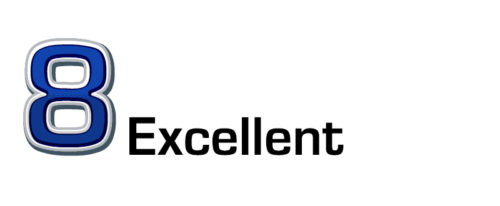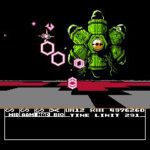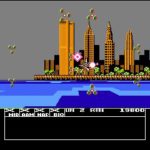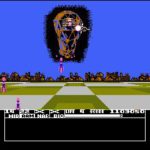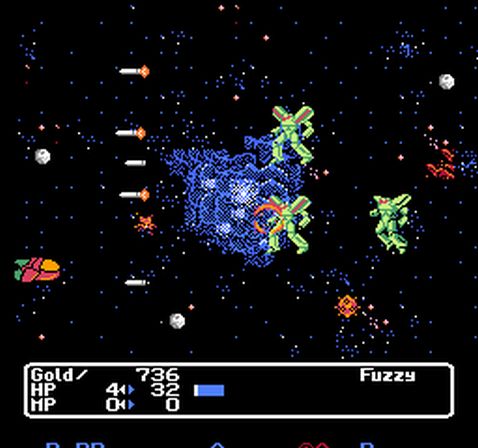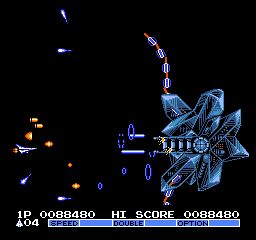Developer: Home Data Corp. Publisher: Taito Released: 1991 Genre: Shooter Platform: NES
I can admit to being insanely jealous that Sega Master System owners had a somewhat decent version of Space Harrier. I loved that game in the arcade and would have taken any version of it on a home system. Of course I wasn’t aware of the Famicom port back then but it’s not like it would have mattered. The rail shooter was under represented on the NES with the only example in the US being Tengen’s After Burner. Admirable but the less said about that game the better. In Japan there was a greater variety to choose from with Tetrastar quite possibly being the best. It is also quite the technical powerhouse as well with the gameplay to back it up.
In the year 2089 mankind forms an alliance with the intergalactic Baal Empire. Unfortunately this is just a front as the Baal eventually attack the Earth. General Nelson leads a resistance force to drive back the Baal Empire and to eventually assault them on their home world and end their threat once and for all.
Tetrastar is very similar to Cosmic Epsilon, the developer’s prior work. Both games share the same viewpoint and general gameplay. Except everything is simply tighter and more accomplished this time around. The story (such as it is, this is still a shooter) is more involved with cutscenes after every level and even a little bit of melodrama thrown in towards the end. Overall this is a more satisfying package which is really saying something as I really liked Cosmic Epsilon.
I wish I could say your ship comes equipped with a complement of cool weapons but that isn’t the case. Of the four the only one you’ll find consistently useful are the anti-air missiles. These bad boys possess homing capabilities and make the harder boss battles manageable. The wide bombs are a blessing when you are on a planet’s surface but are useless in space where half the game takes place. Napalm bombs are similar and the all-powerful bio cannon is best left for boss battles as its charge time is not conducive for felling quick witted enemy ships.
While that may be disappointing the game’s flow makes up for it. Each level brings something new, whether it be an awesome scenario or some technical feat. The first stage is a defense of New York with predictable enemy waves assaulting the city. Next is destroying the enemies surrounding their warp gate to save Omega, your copilot. With Omega in tow you assault the Baal’s home planet but it turns out to be a false lead. Next you disguise your ship as an enemy fighter for the next adventure to destroy the super computer Belzegal. If you choose you can avoid firing a single shot until the end to preserve your cover. Very cool. The real Belzegal is far away and when you eventually reach the final stage you’ll have to prepare for one of the most intense final boss battles on the NES.
As much as I like Tetrastar it does share many of the same flaws as every game in this genre. The viewpoint makes dodging bullets and targeting enemies extremely hard. There are no cross hairs to line up shots and most of your special weapons work best on ground based targets. This can be pretty aggravating, especially during certain boss battles with strict time limits. Judging the distance of enemies becomes an even bigger problem late in the game since they move so fast. Making matters worse sprite flickering means you’ll die sometimes without seeing how.
This is not an easy game as a result. The early stages lull you into a false sense of security as enemy waves are few and their shots fewer. That changes around level three at which point you’ll face more aggressive enemies and a variety of traps. It only gets worse from there. I do feel a simple life bar would have eased the difficulty without breaking the game but others may disagree. I will say as brutal as the final boss is the ending is very satisfying and worth the trouble.
It’s no exaggeration to say that Tetrastar is one of the most technically accomplished games for the system. There are a number of games that used software scaling on the NES but none look this good, technically and artistically. Each new world is impressive in its level of detail and even the generic space battles manage to remain visually interesting thanks to the number of sprites on screen and the weird warping effect the game uses for its backgrounds at times. The final level in particular is just fantastic and one of my favorite 8-bit environments of all time. And the developers even managed to squeeze in a number of cutscenes! There is some sprite flicker but slowdown is rare surprisingly. This is a top notch production all around and it shows.
The soundtrack is probably the only disappointing aspect of the game. Rather than an original score the soundtrack is 8-bit renditions of classical music from the public domain. You’ll probably recognize classics such as Ride of the Valkyries and William Tell and admittedly these are pretty good for what they are. But the music is a complete mismatch for the game and blatantly sticks out as a result.
In Closing
Tetrastar has a few problems with its viewpoint but that is unavoidable. It’s a bit more difficult than I would have liked but that does not detract from the game in my opinion. It is worth it just to see your NES do things it was not designed for and the fact the game is so good is a nice bonus as well.
